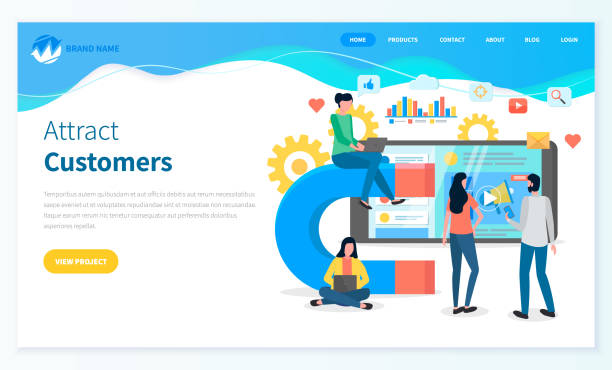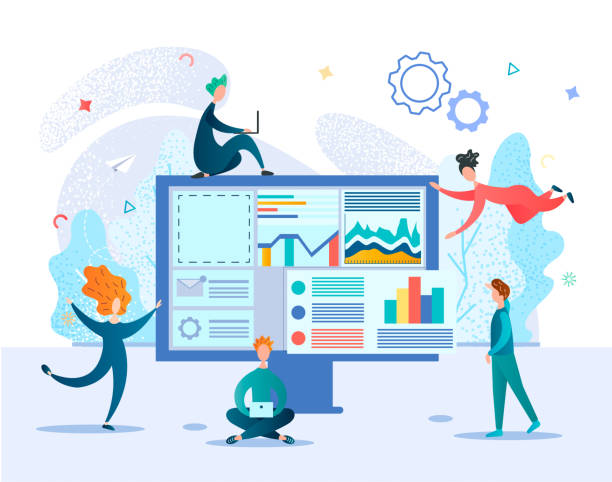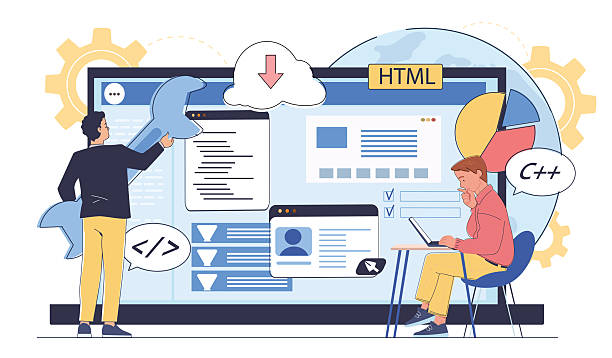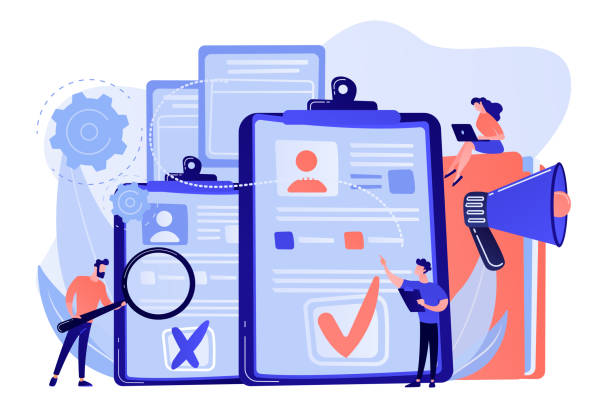Introduction to the Importance of Speed in Website Design

In today’s digital world, speed is a critical factor for the success of any website.
Users expect websites to load immediately, and no one is willing to wait for slow sites.
This is where the concept of fast website design shows its importance.
A fast-loading website not only provides a better user experience (UX) but also plays a key role in search engine rankings.
Google and other search engines prioritize faster sites, which means better SEO.
#Website_Speed not only helps retain visitors but also improves conversion rates.
Suppose a user enters your site to buy a product; if the site is slow, he will easily go to your competitors.
Therefore, fast website design is an essential investment for any online business.
Optimizing website performance and reducing load time are among the fundamental principles of building a high-speed website.
This is not just a technical discussion but a powerful marketing strategy that can make a significant difference in your online success.
In the rest of this article, we will examine various aspects of fast website design and practical solutions to achieve it.
Speed is a factor that can distinguish your business in this competitive market.
Are you concerned about your online store’s low conversion rate and not achieving your desired sales?
Rasaweb is your specialized solution for having a successful online store.
✅ Significant increase in conversion rate and sales
✅ Professional and user-friendly design to attract customer satisfaction
⚡ Ready for a transformation in online sales? Get a free consultation!
Key Principles for Increasing Website Speed

Achieving fast website design requires adherence to a set of principles and rules that cover everything from initial planning stages to website implementation and maintenance.
The first principle is choosing appropriate hosting (web hosting).
Shared hosting might be cheap to start with, but for website speed optimization in the long run, dedicated, VPS, or cloud hosts are better options.
The second principle is optimizing images and multimedia content.
Images consume a large amount of bandwidth, so compressing them without losing quality and using modern formats like WebP can have a dramatic effect on site loading speed.
The third principle is using caching.
Caching allows browsers to store your website’s static files, so in subsequent visits, they don’t need to be downloaded again, significantly reducing load time.
The fourth principle is cleaning up codes and removing unnecessary codes (minification).
Reducing the size of CSS, JavaScript, and HTML files by removing white spaces, comments, and unnecessary codes helps speed up the rendering process.
The fifth principle is using a Content Delivery Network (CDN).
A CDN copies your website content to various servers around the world, and when a user visits your site, the content is delivered from the closest server to them, reducing physical distance and response time.
These principles together form the basis of fast web development and help you have a high-performance site.
The Impact of Hosting and CDN on Speed and How to Optimize Images

As mentioned earlier, choosing appropriate hosting and using a CDN are two crucial factors in fast website design.
Poor hosting, even with the best coding and optimization, can slow down your website.
High-quality hosts have optimized servers, sufficient dedicated resources, and strong technical support that will guarantee your website’s fast performance.
Also, the geographical location of the server is important; if your audience is in Iran, local servers can provide a better experience.
CDN, or Content Delivery Network, is an unparalleled solution for improving site loading speed, especially for global audiences.
By caching your static content (such as images, CSS, JavaScript) in points around the world, CDN ensures that users receive content from the closest server, minimizing latency.
This significantly helps increase website speed and reduce the load on your main server.
In addition to these, image optimization is also of high importance.
High-quality images can be very large and drastically increase page load time.
To optimize images, you can use the following methods:
- Image Compression: Use online tools or plugins to reduce image size without significant quality loss.
- Choosing the Right Format: Use modern formats like WebP, which have smaller sizes and offer good quality, or JPG for photos and PNG for images with transparency.
- Resizing Images: Resize images to the dimensions they are displayed on the website, no larger.
- Lazy Loading: This technique ensures that images are loaded only when the user scrolls to the relevant section, rather than all images loading simultaneously with the initial page load.
In the table below, you can see a comparison of hosting types and their impact on speed:
| Hosting Type | Key Features | Impact on Speed | Suitable For |
|---|---|---|---|
| Shared Hosting | Shared resources, inexpensive, simplicity | Low to Medium (depends on neighbors’ traffic) | Personal and small websites |
| Virtual Private Server (VPS) | Virtual dedicated resources, high flexibility | Medium to High (more control over performance) | Medium websites, online stores |
| Cloud Hosting | High scalability, pay-as-you-go, distributed | High and very stable (no dependency on a single physical server) | High-traffic websites, SaaS |
| Dedicated Server | All server resources at your disposal, full control | Very High (maximum possible performance) | Very large websites, specific applications |
The Role of Optimized Coding and Modern Frameworks in Speed Improvement

One of the most important pillars of fast website design is optimized coding.
Messy, repetitive, or unnecessary code can severely reduce website load and processing speed.
Developers should note that every line of code they write has a direct impact on the site’s final performance.
Optimizing CSS, JavaScript, and HTML codes includes removing comments, extra white spaces, and compressing them (minification).
This reduces file sizes and, consequently, reduces download time by the browser.
Also, consolidating and combining CSS and JavaScript files into one or more larger files (concatenation) can reduce the number of HTTP requests.
Each HTTP request requires time to send and receive a response from the server, so by reducing the number of these requests, load speed significantly increases.
Using modern frameworks and JavaScript libraries can also contribute to fast web development.
Frameworks like React, Vue.js, and Angular enable the creation of dynamic and fast user interfaces.
These frameworks use techniques such as Virtual DOM (in React) or reusable components, which increase the efficiency and rendering speed of pages.
However, their correct use and avoiding overloading with unnecessary libraries are crucial for maintaining website speed.
Code Splitting is also an advanced technique used in modern frameworks.
This technique allows you to divide JavaScript code into smaller chunks and load only those chunks necessary for displaying a specific part of the page.
This significantly helps fast website design, especially for large and complex pages.
Are you tired of your company’s website not being seen as it deserves, losing potential customers? Solve this problem forever with professional and effective website design by Rasaweb!
✅ Increase brand credibility and gain customer trust
✅ Attract targeted sales leads
⚡ Contact us now for a free consultation!
The Impact of Website Speed on User Experience and SEO

Website speed is not just a technical feature but a strategic factor for online success.
The impact of fast website design on user experience (UX) and SEO is undeniable.
From a user’s perspective, a website that loads quickly conveys a sense of satisfaction and efficiency.
Today’s users are impatient; research shows that a significant portion of users will leave a website if it takes more than a few seconds to load.
This early departure leads to an increased Bounce Rate, which is one of the negative signals for search engines.
In contrast, a high-speed website allows users to easily and without delay navigate between different pages, fill out forms, and quickly perform their interactions, which in turn leads to increased user satisfaction and the likelihood of their returning to the site.
From an SEO perspective, site speed has been announced as an official ranking factor by Google years ago.
Google’s algorithms attach great importance to website performance.
Faster sites not only provide a better user experience but also allow Google’s crawling bots to review more pages in less time (Crawl Budget).
This means your content is indexed faster and has a better chance of appearing in search results.
Furthermore, with the introduction of metrics like Core Web Vitals, Google has increasingly emphasized the performance aspects of websites.
LCP (Largest Contentful Paint), FID (First Input Delay), and CLS (Cumulative Layout Shift) are three key metrics that measure website load speed, interactivity, and visual stability.
Improving these metrics directly contributes to increasing website speed and, consequently, to improving SEO rankings.
Therefore, any investment in fast website design is an investment in the future of your online business and will yield significant return on investment.
Tools and Metrics for Measuring Website Speed

To ensure that your efforts for fast website design are effective, you need accurate tools for measuring and monitoring performance.
Fortunately, powerful tools are available to help you identify and resolve speed bottlenecks.
One of the most well-known and useful tools is Google PageSpeed Insights.
This tool gives you a score from 0 to 100 for website speed on mobile and desktop devices and also provides suggestions for performance improvement.
These suggestions include items such as image optimization, enabling browser caching, reducing server response time, and more.
Another tool is GTmetrix, which provides a deeper analysis of your site’s performance.
This tool supports Core Web Vitals and displays waterfall charts that show the loading time of each element on the page individually.
These charts are very useful for identifying slow loading resources.
Pingdom Tools is another popular tool for checking website speed that allows you to select the geographical location of the test server.
This feature helps you evaluate your site’s performance from the perspective of users in different regions.
Key metrics you should pay attention to include:
- First Contentful Paint (FCP): The time when the first part of the content appears on the screen.
- Largest Contentful Paint (LCP): The time when the largest visible content element on the page is loaded.
(One of the Core Web Vitals) - Total Blocking Time (TBT): The duration for which the page is not interactive with the user due to script execution.
- Cumulative Layout Shift (CLS): Measures the visual stability of the page.
(One of the Core Web Vitals) - Time to Interactive (TTI): The time when the page becomes fully interactive with the user.
- Speed Index: The visual speed of content loading on the page.
Regular monitoring of these metrics and using the mentioned tools is an inseparable part of the website speed optimization process and ensuring fast and efficient website design.
Improving Backend and Database Performance for Speed Increase

Often the focus is on optimizing the Front-end for fast website design, but Back-end and Database performance are equally vital.
A slow backend can drastically increase server response time, making your website seem slow even with the best front-end optimizations.
To improve backend performance, the first step is server code optimization.
Using efficient programming languages, optimized algorithms, and proper code structuring can reduce request processing time.
Using optimized frameworks for backend languages (such as Laravel for PHP, Django for Python, Express for Node.js) that have efficient architectures and internal optimization tools is also recommended.
Database optimization is also of high importance.
Large databases or inefficient queries can consume a lot of time for retrieving information.
Key solutions for database optimization include:
- Proper Indexing: Ensuring that frequently used fields in database tables are properly indexed.
Indexes allow the database to find information much faster. - Query Optimization: Rewriting SQL queries for greater efficiency.
Using optimized JOINs, avoiding SELECT *, and filtering data on the database side rather than the server side, can increase speed. - Normalization and Denormalization: Choosing correctly between normalization (to reduce data redundancy) and denormalization (to reduce JOINs) based on specific website needs.
- Database Caching: Using caching systems (like Redis or Memcached) to store the results of frequently used queries.
This reduces the need for re-searching the database. - Periodic Cleanup: Removing old or unnecessary data from the database.
Also, using server-side caching is very effective.
This type of caching can store full page results, content fragments, or API responses, thus eliminating the need for reprocessing the request each time.
This directly contributes to increasing website speed and reducing the load on the server.
A strong backend and an optimized database form the foundation of a high-speed site.
Common Mistakes in Website Design and Their Quick Solutions

In the process of fast website design, many developers and website owners make mistakes that can lead to reduced performance and a poor user experience.
Understanding these mistakes and knowing their solutions is essential for website speed optimization.
One of the most common mistakes is excessive use of plugins and extensions.
Every plugin you install adds code to your website and can lead to an increased number of HTTP requests and file sizes.
Solution: Use only essential and reputable plugins.
Remove old and inactive plugins.
Before installing any plugin, review user comments and its impact on performance.
Another mistake is lack of image optimization, which was mentioned earlier.
High-volume images can severely slow down the page.
Solution: Compress and resize images appropriately.
Use modern formats like WebP and enable lazy loading.
Not using caching is also a big mistake.
Without caching, every time a user visits your site, all content must be reloaded from the server.
Solution: Use powerful caching plugins (for Content Management Systems) or server-side caching mechanisms (for custom websites).
Choosing inappropriate hosting can also nullify all your efforts for fast website design.
Solution: Choose hosting that is suitable for your website’s traffic volume and needs, and has optimized hardware and software.
Lack of database optimization and inefficient queries are also important mistakes.
Solution: Regularly optimize and index the database.
Rewrite SQL queries for better performance.
Not compressing with Gzip for text files (HTML, CSS, JavaScript) increases transfer time.
Solution: Enable Gzip compression on your server.
This significantly reduces file sizes.
By avoiding these mistakes and implementing their solutions, you can significantly improve your website speed and provide a better user experience.
The table below summarizes some common problems and their solutions for site optimization:
| Common Problem | Impact on Speed | Suggested Solution |
|---|---|---|
| Unoptimized images | Increased page size, slow loading | Compression, resizing, WebP, Lazy Load |
| Too many/unnecessary plugins | Increased HTTP requests, loading extra code | Remove unnecessary plugins, use coding alternatives |
| Lack of caching | Full content loading on every visit | Enable browser and server caching |
| Inappropriate hosting | High server response time, limited resources | Choose high-speed hosting (VPS/Cloud) |
| Uncompressed CSS/JS codes | Increased file size, slow parsing | Minification and Concatenation |
Are losing customers because of your online store’s outdated appearance or slow speed bothering you? Rasaweb’s expert team solves these problems with professional online store design!
✅ Increase customer trust and your brand’s credibility
✅ Stunning speed and excellent user experience
Get a free consultation with Rasaweb right now ⚡
The Future of Fast Website Design and Emerging Technologies

The web world is rapidly evolving, and with it, new technologies emerge to ensure fast and efficient website design.
Emerging trends and technologies indicate that the focus on speed will not only continue but will also become deeper and more comprehensive.
One of these technologies is AMP (Accelerated Mobile Pages) from Google.
AMP ensures instant content loading by providing an optimized version of web pages for mobile devices, which is crucial for fast website design in today’s mobile-first world.
PWA (Progressive Web Apps) is another approach that allows sites to offer a native app-like experience in the browser.
PWAs significantly improve user experience with features like offline functionality, push notifications, and quick home screen access, and contribute to increasing website speed through advanced caching.
The advent of HTTP/3, the latest version of the HTTP protocol, also promises unprecedented speeds.
Built on the QUIC protocol, HTTP/3 addresses Head-of-Line Blocking issues in HTTP/2 and provides faster and more reliable connections by using UDP instead of TCP.
These advancements directly impact site loading speed.
Technologies related to Artificial Intelligence (AI) and Machine Learning (ML) are also entering the field of website optimization.
These technologies can be used to analyze user behavior, predict loading needs, and optimize resources in real-time.
For example, AI can automatically compress images or suggest the best caching strategy based on traffic patterns.
Furthermore, Edge Computing, which processes data closer to the user instead of central servers, can minimize latency and contribute to high-speed website development.
These trends indicate that the future of fast website design will be built upon faster connections, optimized content, and intelligent approaches to data delivery.
Successful Examples of Fast Website Design and Their Lessons

Examining successful examples of fast website design can be inspiring and provide practical guidance for others.
Many large companies and successful platforms have invested heavily in their website speed and have achieved significant results.
One of the most prominent examples is Google.
Google itself, as a search engine, is a prime example of a high-speed site.
Although there are many technical complexities behind it, the main lesson is that even for large and content-rich projects, speed can be a priority.
Google’s emphasis on Core Web Vitals and tools like PageSpeed Insights is a testament to the importance of speed itself.
Amazon, the e-commerce giant, is another example.
Years ago, Amazon realized that every 100 milliseconds of page load delay could result in millions of dollars in lost sales.
This awareness has led them to continuous investment in website speed optimization.
They use extensive CDNs, advanced caching systems, and scalable architectures to ensure fast loading of their pages.
Facebook and Twitter are also examples of platforms that, with a massive volume of dynamic content and active users, strive to maintain high speed.
They use technologies like PWA and distributed systems to provide a fast and smooth experience for their users.
Netflix, which streams a large amount of multimedia content, also heavily focuses on optimizing content delivery.
They utilize Content Delivery Networks (CDNs) to ensure that users worldwide can watch videos with minimal buffering and maximum speed.
Lessons learned from these examples include:
- Speed is a strategic priority: It must be considered from the very beginning of the fast website design process.
- Continuous investment: Website speed optimization is not a one-time process but requires continuous monitoring and improvement.
- Use of advanced technologies: Leveraging CDNs, caching, Minification, and modern frameworks is essential.
- Attention to all aspects: Both front-end and back-end must be optimized.
- Monitoring and measurement: Using analytical tools to identify problems and track progress is crucial.
These examples show that fast website design is a fundamental factor for success on various scales.
Frequently Asked Questions
| Number | Question | Answer |
|---|---|---|
| 1 | What does fast website design mean? | Optimizing a website for fast page loading, improving user experience, and SEO ranking. |
| 2 | Why is website loading speed important? | Increases user satisfaction, reduces bounce rate, improves SEO, and boosts conversion rates (sales/actions). |
| 3 | What tools are available for testing website speed? | Google PageSpeed Insights, GTmetrix, Pingdom Tools are common tools. |
| 4 | What are the main factors slowing down a website? | Unoptimized images, heavy JavaScript and CSS codes, poor hosting, and lack of caching. |
| 5 | What is “Caching” and how does it help website speed? | Temporarily storing site data in the user’s browser or server for faster loading on subsequent visits. |
| 6 | How to optimize images to increase website speed? | Reducing image size (compression) without significant quality loss, using modern formats (WebP), and setting appropriate dimensions. |
| 7 | What role does CDN (Content Delivery Network) play in fast website design? | Distributing website content across various servers worldwide to deliver content from the closest server to the user. |
| 8 | Does choosing appropriate hosting (web hosting) affect website speed? | Yes, quality hosting with powerful servers is essential for fast site loading. |
| 9 | What is the Minification technique and why is it used? | Removing extra characters (white spaces, comments) from HTML, CSS, JavaScript codes to reduce file sizes. |
| 10 | What is the relationship between responsive design and website speed? | Responsive design means correct display on different devices; if not implemented properly, it can create extra load and reduce speed. Responsive optimization is important for speed. |
And other services of Rasaweb Advertising Agency in the field of advertising
- Smart Social Media: A professional solution for customer acquisition focusing on customizing user experience.
- Smart Digital Advertising: A novel service for increasing website visits through precise audience targeting.
- Smart Digital Advertising: A professional solution for increasing website visits focusing on optimizing key pages.
- Smart Sales Automation: A fast and efficient solution for increasing click-through rates focusing on attractive user interface design.
- Smart Advertising Campaign: A fast and efficient solution for analyzing customer behavior focusing on marketing automation.
And over a hundred other services in the field of internet advertising, advertising consultation, and organizational solutions
Internet Advertising | Advertising Strategy | Advertorials
Sources
Increase Website Speed – Host Iran
Website Speed Increase and Optimization – Hamyar Site
Increase Website Speed – Webram
Comprehensive Guide to Increasing Website Speed – Pars Mizban
? Are you looking to upgrade your business in the digital world?
Rasaweb Afarin Digital Marketing Agency, specializing in custom website design, Search Engine Optimization (SEO), and managing advertising campaigns, helps you have a powerful and effective presence in the online space.
Let us take your business to the top with innovative and creative solutions. For a free consultation and more information, contact our experts.
📍 Tehran, Mirdamad Street, next to Central Bank, Southern Kazeroun Alley, Ramin Alley, No. 6



